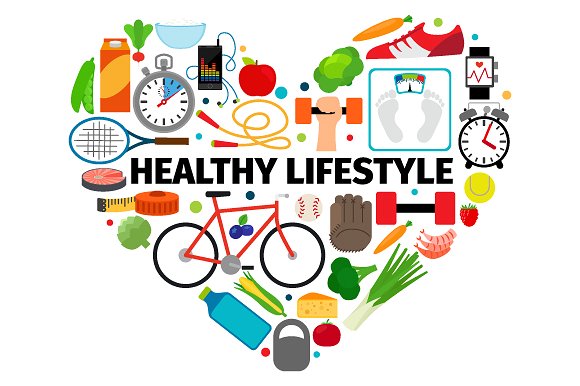Health, Miscellaneous
Which Is More Important – Your Health Or The Environment?
Back in time, the World Health Organization (WHO) defines health as “a condition of complete physical, mental, and social well-being and not merely the absence of disease or infirmity.”
This definition quite serves as a reminder which helps one revisit the importance of environmental health and the natural environment that demand one’s willingness to follow a variety of approaches.
Pure air, plants, water, and food supplies are essential for our health and well being. The relationship between environment and health is one of interdependence where one affects the other.
Therefore, just as our actions and choices can impact the environment, the health of the planet in return influences our health and well being, along with our families, communities, and economies.
Humans have an inborn connection to nature with research indicating that just loitering around greenery can boost one’s mood and lower blood pressure, as well as enhance attention and the attitude towards problem-solving.
The human connection to nature and the point that this might be an element of good health has a long and fascinating history of art, philosophy, and popular culture.
There is ample evidence right from plants, landscapes, animals, and wild experiences that one can build on this affiliation to enhance their health.
 Common sense shows that a good environment is a must for human health. However, only in recent times have science and technology equipped us with schemes that can fathom the link between a healthy environment and a healthy body.
The Earth sustains on its own naturally through photosynthesis, as the sun imparts energy to plants, which in turn will produce oxygen for animals to live. Even our bodies decompose and are once again dissolved in the earth.
This natural cycle cannot produce unnecessary waste as every part of the system is interconnected and used to enable life.
But humans disturb this balance by producing toxic waste that is harmful to the Earth, along with burning fossil fuels and overusing natural resources.
The effects of our actions in an extremely industrialized society are alarming and indisputable where we are creating conditions that will eventually harm the life on this planet to the point they perish.
To put things into perspective, across the globe, we as a generation are currently using the resources of 1.5 planets, calling for the scarcity of resources on many levels.
Common sense shows that a good environment is a must for human health. However, only in recent times have science and technology equipped us with schemes that can fathom the link between a healthy environment and a healthy body.
The Earth sustains on its own naturally through photosynthesis, as the sun imparts energy to plants, which in turn will produce oxygen for animals to live. Even our bodies decompose and are once again dissolved in the earth.
This natural cycle cannot produce unnecessary waste as every part of the system is interconnected and used to enable life.
But humans disturb this balance by producing toxic waste that is harmful to the Earth, along with burning fossil fuels and overusing natural resources.
The effects of our actions in an extremely industrialized society are alarming and indisputable where we are creating conditions that will eventually harm the life on this planet to the point they perish.
To put things into perspective, across the globe, we as a generation are currently using the resources of 1.5 planets, calling for the scarcity of resources on many levels.
 Advances in the environmental health field have taught us a lot about human health hazards; for example, heavy metals can cause neurotoxicity, air pollution can cause respiratory disease, global climate change can fuel the spread of infectious diseases and so on.
Environmental health issues customarily have been dealt with at the international level within the context of problems such as climate change, ozone depletion, and biodiversity.
Nations have tried to address these issues through the multilateral process like multilateral agreements and commissions, bilateral assistance and cooperation, trade, private sector investment, education, the work of non-governmental organizations, and training.
Following are some points one must bear in mind that causes good environment and thereby, good health:
Advances in the environmental health field have taught us a lot about human health hazards; for example, heavy metals can cause neurotoxicity, air pollution can cause respiratory disease, global climate change can fuel the spread of infectious diseases and so on.
Environmental health issues customarily have been dealt with at the international level within the context of problems such as climate change, ozone depletion, and biodiversity.
Nations have tried to address these issues through the multilateral process like multilateral agreements and commissions, bilateral assistance and cooperation, trade, private sector investment, education, the work of non-governmental organizations, and training.
Following are some points one must bear in mind that causes good environment and thereby, good health:
 Take a walk, go bicycling or carpooling, use public transportation or do anything other than driving. We can also adopt “eco-driving” which requires taking measures like maintaining a steady speed, being proactive while driving as well as keeping tires inflated enough.
By utilizing Energy Star appliances and residing in well-insulated homes, one can reduce their heating cum cooling needs thereby reducing fluorocarbon emissions.
Limiting electricity consumption and decreasing mined metals through recyclable and sustainable building materials are some other ways to restrict the usage of earth’s resources that can potentially harm both nature and human health.
Take a walk, go bicycling or carpooling, use public transportation or do anything other than driving. We can also adopt “eco-driving” which requires taking measures like maintaining a steady speed, being proactive while driving as well as keeping tires inflated enough.
By utilizing Energy Star appliances and residing in well-insulated homes, one can reduce their heating cum cooling needs thereby reducing fluorocarbon emissions.
Limiting electricity consumption and decreasing mined metals through recyclable and sustainable building materials are some other ways to restrict the usage of earth’s resources that can potentially harm both nature and human health.
 Supporting and advocating sustainable agriculture by purchasing certified organic food cum clothing, choosing environmentally sound and non-toxic furniture, toys, paints, carpets, renovation materials and a list of eco-friendly products, using green dry-cleaners and drinking from reusable cups/bottles, employing natural pest control in one’s backyard/gardens and purchasing non-toxic cleaners, etc are ways that one can check toxic substance usage.
Supporting and advocating sustainable agriculture by purchasing certified organic food cum clothing, choosing environmentally sound and non-toxic furniture, toys, paints, carpets, renovation materials and a list of eco-friendly products, using green dry-cleaners and drinking from reusable cups/bottles, employing natural pest control in one’s backyard/gardens and purchasing non-toxic cleaners, etc are ways that one can check toxic substance usage.
 Reducing paper use, using reusable shopping bags, using recycled toiletries, eating low on food-chain by opting for an organic, plant-based diet, reducing consumption of factory-made foods, composting yard material and food scraps along with protecting and conserving precious rainwater are some easy measures to respect and protect the earth.
Reducing paper use, using reusable shopping bags, using recycled toiletries, eating low on food-chain by opting for an organic, plant-based diet, reducing consumption of factory-made foods, composting yard material and food scraps along with protecting and conserving precious rainwater are some easy measures to respect and protect the earth.
 Meeting the basic needs of fellow human beings with initiatives like converting one of the bank accounts into a socially accountable fund, community or co-operative bank;
Buying organically certified fair trade products that help provide decent wages and safe working conditions for workers, volunteering and offering help to someone in one’s community or environmental group, following good human ethics, and caring for others in the society in any possible manner are some ways in helping others meet their basic needs.
Meeting the basic needs of fellow human beings with initiatives like converting one of the bank accounts into a socially accountable fund, community or co-operative bank;
Buying organically certified fair trade products that help provide decent wages and safe working conditions for workers, volunteering and offering help to someone in one’s community or environmental group, following good human ethics, and caring for others in the society in any possible manner are some ways in helping others meet their basic needs.
 Making changes in your life that aim to protect the health of the global environment will naturally benefit you as well, sometimes in unexpected ways. After all, the health of the planet is inextricably linked to the well being of the individual.
The natural environment, broadly conceived, can also enhance health, for example, many pharmaceuticals are derived from plants and animals, providing a compelling argument for preserving biodiversity. In addition, contact with the natural world may be directly beneficial to health.
If so, then the field of environmental health needs to go beyond mere considerations of toxicity.
According to the speakers, research and policy must be directed towards absorbing the interactions of human health and the natural environment, from the most personal level, that is, how individuals interact with the world around them to the global scale—that is, how nations accede to reduce pollution, seek firm agricultural and land use practices, and feed their citizens.
http://www.ehinz.ac.nz/indicators/overview/what-is-environmental-health/
https://greenliving.lovetoknow.com/Why_is_Our_Environment_Important
Making changes in your life that aim to protect the health of the global environment will naturally benefit you as well, sometimes in unexpected ways. After all, the health of the planet is inextricably linked to the well being of the individual.
The natural environment, broadly conceived, can also enhance health, for example, many pharmaceuticals are derived from plants and animals, providing a compelling argument for preserving biodiversity. In addition, contact with the natural world may be directly beneficial to health.
If so, then the field of environmental health needs to go beyond mere considerations of toxicity.
According to the speakers, research and policy must be directed towards absorbing the interactions of human health and the natural environment, from the most personal level, that is, how individuals interact with the world around them to the global scale—that is, how nations accede to reduce pollution, seek firm agricultural and land use practices, and feed their citizens.
http://www.ehinz.ac.nz/indicators/overview/what-is-environmental-health/
https://greenliving.lovetoknow.com/Why_is_Our_Environment_Important
How Are Human Health And Environment Related?
 Common sense shows that a good environment is a must for human health. However, only in recent times have science and technology equipped us with schemes that can fathom the link between a healthy environment and a healthy body.
The Earth sustains on its own naturally through photosynthesis, as the sun imparts energy to plants, which in turn will produce oxygen for animals to live. Even our bodies decompose and are once again dissolved in the earth.
This natural cycle cannot produce unnecessary waste as every part of the system is interconnected and used to enable life.
But humans disturb this balance by producing toxic waste that is harmful to the Earth, along with burning fossil fuels and overusing natural resources.
The effects of our actions in an extremely industrialized society are alarming and indisputable where we are creating conditions that will eventually harm the life on this planet to the point they perish.
To put things into perspective, across the globe, we as a generation are currently using the resources of 1.5 planets, calling for the scarcity of resources on many levels.
Common sense shows that a good environment is a must for human health. However, only in recent times have science and technology equipped us with schemes that can fathom the link between a healthy environment and a healthy body.
The Earth sustains on its own naturally through photosynthesis, as the sun imparts energy to plants, which in turn will produce oxygen for animals to live. Even our bodies decompose and are once again dissolved in the earth.
This natural cycle cannot produce unnecessary waste as every part of the system is interconnected and used to enable life.
But humans disturb this balance by producing toxic waste that is harmful to the Earth, along with burning fossil fuels and overusing natural resources.
The effects of our actions in an extremely industrialized society are alarming and indisputable where we are creating conditions that will eventually harm the life on this planet to the point they perish.
To put things into perspective, across the globe, we as a generation are currently using the resources of 1.5 planets, calling for the scarcity of resources on many levels.
It’s Not Just About Nature – Biodiversity And Human Health!
We must see that sustainability and global environmental health is not simply about what is “green” as there is a human element attached to it. Though humans are the major culprits for the degradation of the planet, we are also a natural part of the cycle and must be well protected. There is a significant connection between the diversity of life on earth and our own well-being. Another central predicament is the reduction and waste disposal. We cannot continue but have consumption which outweighs the production capacity of ecosystems, and hence produce waste at a rate that outweighs our ability to put it back into the ecosystems from harmful impacts. A second challenge is to grow baseline data on different environmental stressors. There can be direct or indirect impacts of a poor environment on public health. The linear effects of pollution on public health such as toxicity or adverse health effects and less on the bioindicators can measure direct and indirect effects through impacts on ecological systems.Tips To Consider For A Good Health And A Good Environment
 Advances in the environmental health field have taught us a lot about human health hazards; for example, heavy metals can cause neurotoxicity, air pollution can cause respiratory disease, global climate change can fuel the spread of infectious diseases and so on.
Environmental health issues customarily have been dealt with at the international level within the context of problems such as climate change, ozone depletion, and biodiversity.
Nations have tried to address these issues through the multilateral process like multilateral agreements and commissions, bilateral assistance and cooperation, trade, private sector investment, education, the work of non-governmental organizations, and training.
Following are some points one must bear in mind that causes good environment and thereby, good health:
Advances in the environmental health field have taught us a lot about human health hazards; for example, heavy metals can cause neurotoxicity, air pollution can cause respiratory disease, global climate change can fuel the spread of infectious diseases and so on.
Environmental health issues customarily have been dealt with at the international level within the context of problems such as climate change, ozone depletion, and biodiversity.
Nations have tried to address these issues through the multilateral process like multilateral agreements and commissions, bilateral assistance and cooperation, trade, private sector investment, education, the work of non-governmental organizations, and training.
Following are some points one must bear in mind that causes good environment and thereby, good health:
- Biodiversity is essential for assuring the human healthiness. Biological diversity also works as a set of indicators for environmental reform, for example, the study of endocrine-disrupting chemicals in wild species and the decline and disappearance of the world’s amphibian species. Thus, Biological diversity becomes the ultimate integrator of all the things affecting living systems.
- An additional way in which biodiversity benefits human health is in decreasing environmentally induced disease. There is an actual field relating to biological systems, generally, microbes, to dress up toxic waste problems in the environment, especially PCBs, oil spills, and heavy metals. Biological methods more and more are being seen as a potential means of cleaning up the water supply through the restoration of watersheds.
- Agriculture instantly affects human health in two major ways: (1) through the ecosystem and environmental changes in farm production and (2) through the available nutritious food supply.
- Federal agricultural drives aim at developing new technologies to protect the environment by shifting to lower-risk pesticides or pesticide alternatives and by conducting research on greenhouse gases and carbon storage that will affect global climate change.
- Straws, disposable cups and razors, and plastic grocery bags are some commonplace instances of single-use products in our economy. Attaining a reusable option for these items we use once and throw is a simple way to make a huge difference.
- When shopping, focus on buying locally grown products rather than imported goods as it involves less processing, packaging, and transportation. And it is better to buy local food as local means fresh which tastes quite flavorful.
- Eating extra vegetables and less factory-farmed meats helps reduce greenhouse gases. Meat consumers can try reducing their serving sizes and let the vegetables take center stage on their plates.
- Remains of plants and kitchen waste make nutrient filled food and manure for plants, helping them grow faster through a process called composting. Instead of disposing of one’s wet waste, one can now use it for the plants in their home garden.
- Green living areas in cities and suburbs are vital as industrialization and suburban sprawl have taken away the trees, our main source of pure oxygen. They’re beautiful and do their part in keeping our environment clean. By planting a tree today, one can make green space and unadulterated oxygen a reality for our kids. Not only they are low maintenance, but they also reduce carbon pollution, conserve water, and support the health of local wildlife.
- Changing our travel habits where as much as 90% of road transportation in the U.S. is fueled by oil. If we can walk, bike, or take public transportation, we can significantly reduce our carbon footprint. If we must drive, then making errands at less busy times of the day is better so that we needn’t sit in traffic wasting gas.
- Many industries discard their oil, paint, ammonia and other chemicals publicly. This is dangerous to water and air as these chemicals are steeped into the underground water. When all of these chemicals merge, it’s no wonder today cancer rates have skyrocketed. Supporting regulations and incentives for companies help keep our environment clean.
What Happens When We Ignore The Environment And Human Health?
A healthy environment will obviously result in good health. In fact, most of the diseases that are prevalent today are because of rampant pollution and environmental deterioration. We are at the top of the ecosystem and hence are most vulnerable to environmental degradation. Here are some environmental hazards widespread across the globe which even impacts climate changes everywhere thus adversely affecting the health of all living beings: Air toxics are mostly man-made pollutants that come from substances (like gasoline, dry-cleaning facilities, and paint solvents) which poison the air, water, and food supplies. The EPA warns that subjection to toxic air pollutants can mitigate the risk of cancer, alongside damaging the neurological, reproductive, immune, and respiratory systems. The World Health Organization surmises that air pollution in urban areas is responsible for an approximate 1.3 million deaths worldwide per year, and 19% of all cancers are caused by environmental factors like heating, outdoor air pollution, cooking fuels, and second-hand smoke. According to the EPA, contaminated water can give rise to a large number of health consequences, including gastrointestinal illness, multiplied risk of cancer, liver and kidney damage, reproductive difficulties, central nervous system troubles, and anemia. Bisphenol A (BPA), a chemical much found in the food cans, plastic water bottles, and cash receipts appears to echo the effects of estrogen which may further the risk of reproductive afflictions.5 Simple Things We Can Do For The Environment And Our Health
Nearly every choice we make from what to eat, what to buy, where to shop, how to travel affects the environment on some of the other level. Some choices we make have a specific, direct impact like turning off the light to save electricity. Others have an indirect or distant effect, like purchasing clothing produced in a factory that focuses on safe working conditions for its employees. There are an endless list of things anyone can do in preserving a damage-free environment ensuing spotless health for one and all. Here are 5 things everyone can do to protect their environment and in turn, their health:Limiting What Is Taken From The Earth
 Take a walk, go bicycling or carpooling, use public transportation or do anything other than driving. We can also adopt “eco-driving” which requires taking measures like maintaining a steady speed, being proactive while driving as well as keeping tires inflated enough.
By utilizing Energy Star appliances and residing in well-insulated homes, one can reduce their heating cum cooling needs thereby reducing fluorocarbon emissions.
Limiting electricity consumption and decreasing mined metals through recyclable and sustainable building materials are some other ways to restrict the usage of earth’s resources that can potentially harm both nature and human health.
Take a walk, go bicycling or carpooling, use public transportation or do anything other than driving. We can also adopt “eco-driving” which requires taking measures like maintaining a steady speed, being proactive while driving as well as keeping tires inflated enough.
By utilizing Energy Star appliances and residing in well-insulated homes, one can reduce their heating cum cooling needs thereby reducing fluorocarbon emissions.
Limiting electricity consumption and decreasing mined metals through recyclable and sustainable building materials are some other ways to restrict the usage of earth’s resources that can potentially harm both nature and human health.
Limiting The Use Of Toxic Substances
 Supporting and advocating sustainable agriculture by purchasing certified organic food cum clothing, choosing environmentally sound and non-toxic furniture, toys, paints, carpets, renovation materials and a list of eco-friendly products, using green dry-cleaners and drinking from reusable cups/bottles, employing natural pest control in one’s backyard/gardens and purchasing non-toxic cleaners, etc are ways that one can check toxic substance usage.
Supporting and advocating sustainable agriculture by purchasing certified organic food cum clothing, choosing environmentally sound and non-toxic furniture, toys, paints, carpets, renovation materials and a list of eco-friendly products, using green dry-cleaners and drinking from reusable cups/bottles, employing natural pest control in one’s backyard/gardens and purchasing non-toxic cleaners, etc are ways that one can check toxic substance usage.
Respecting The Need To Protect Mother Earth
 Reducing paper use, using reusable shopping bags, using recycled toiletries, eating low on food-chain by opting for an organic, plant-based diet, reducing consumption of factory-made foods, composting yard material and food scraps along with protecting and conserving precious rainwater are some easy measures to respect and protect the earth.
Reducing paper use, using reusable shopping bags, using recycled toiletries, eating low on food-chain by opting for an organic, plant-based diet, reducing consumption of factory-made foods, composting yard material and food scraps along with protecting and conserving precious rainwater are some easy measures to respect and protect the earth.
Meeting Fundamental Human Needs
 Meeting the basic needs of fellow human beings with initiatives like converting one of the bank accounts into a socially accountable fund, community or co-operative bank;
Buying organically certified fair trade products that help provide decent wages and safe working conditions for workers, volunteering and offering help to someone in one’s community or environmental group, following good human ethics, and caring for others in the society in any possible manner are some ways in helping others meet their basic needs.
Meeting the basic needs of fellow human beings with initiatives like converting one of the bank accounts into a socially accountable fund, community or co-operative bank;
Buying organically certified fair trade products that help provide decent wages and safe working conditions for workers, volunteering and offering help to someone in one’s community or environmental group, following good human ethics, and caring for others in the society in any possible manner are some ways in helping others meet their basic needs.
Opting For A Sustainable Lifestyle
 Making changes in your life that aim to protect the health of the global environment will naturally benefit you as well, sometimes in unexpected ways. After all, the health of the planet is inextricably linked to the well being of the individual.
The natural environment, broadly conceived, can also enhance health, for example, many pharmaceuticals are derived from plants and animals, providing a compelling argument for preserving biodiversity. In addition, contact with the natural world may be directly beneficial to health.
If so, then the field of environmental health needs to go beyond mere considerations of toxicity.
According to the speakers, research and policy must be directed towards absorbing the interactions of human health and the natural environment, from the most personal level, that is, how individuals interact with the world around them to the global scale—that is, how nations accede to reduce pollution, seek firm agricultural and land use practices, and feed their citizens.
http://www.ehinz.ac.nz/indicators/overview/what-is-environmental-health/
https://greenliving.lovetoknow.com/Why_is_Our_Environment_Important
Making changes in your life that aim to protect the health of the global environment will naturally benefit you as well, sometimes in unexpected ways. After all, the health of the planet is inextricably linked to the well being of the individual.
The natural environment, broadly conceived, can also enhance health, for example, many pharmaceuticals are derived from plants and animals, providing a compelling argument for preserving biodiversity. In addition, contact with the natural world may be directly beneficial to health.
If so, then the field of environmental health needs to go beyond mere considerations of toxicity.
According to the speakers, research and policy must be directed towards absorbing the interactions of human health and the natural environment, from the most personal level, that is, how individuals interact with the world around them to the global scale—that is, how nations accede to reduce pollution, seek firm agricultural and land use practices, and feed their citizens.
http://www.ehinz.ac.nz/indicators/overview/what-is-environmental-health/
https://greenliving.lovetoknow.com/Why_is_Our_Environment_Important


